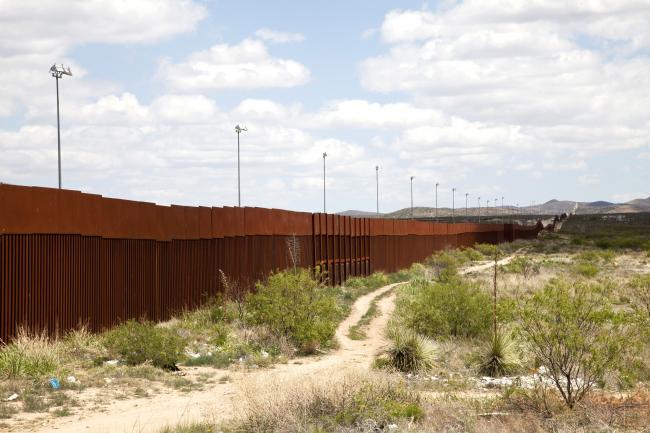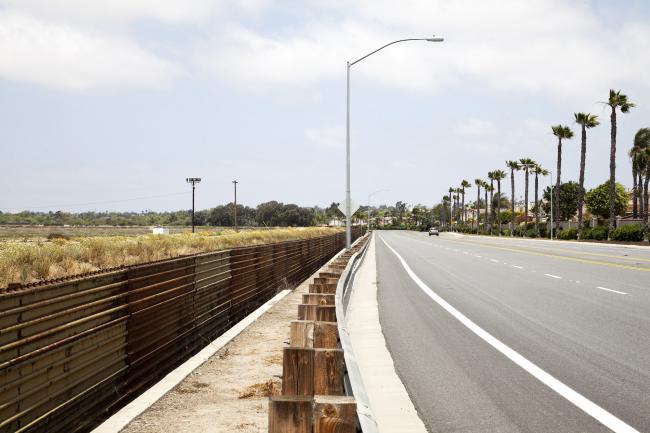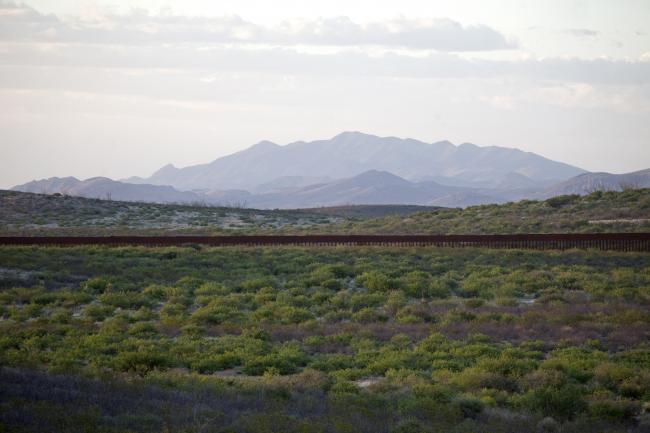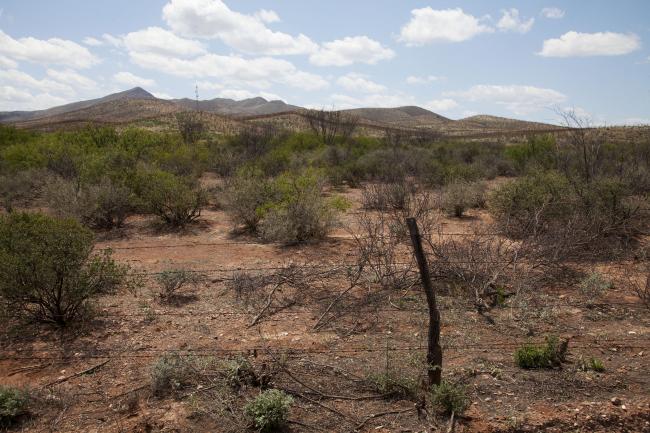This article is accompanied by photography by Ignacio Evangelista. Click here to see his recent photo essay, "The Line on the Map," for NACLA.org.

“A nation without borders is not a nation,” said Donald Trump in his speech issuing an executive order to build more walls along the Mexican border – although the United States already has plenty of border fence and other enforcement apparatus. Polarizing and exaggerated statements like this occur often when speaking about nation-state borders. What kinds of thinking make this statement plausible and, among some groups, appealing? In particular, how is border thinking deployed in dominant U.S. ideas about the U.S.-Mexico border?
A few precautions are in order. In addressing these questions, I focus on the thinking itself, and set aside for the moment historical and social contexts. In characterizing concepts, I do not address how they match empirical reality. I am quite critical of border thinking. But I also ask if border thinking can be shifted – towards promoting, rather than severing – relationships between nations?
A border divides in and out, here and there, self and other. It not only distinguishes, but it separates, actively pushing the sides apart. A wall, then, is a materialization of divisive thinking. Simplification often accompanies this process of drawing distinctions. Border lines slice apart gradation, making apparently clear and evident that which actually blends across society and space. Border lines also clarify—and in important ways deny—ambiguity, the simultaneity of differences and opposites. Yet, the world is gradated and ambiguous, and border thinking can easily oversimplify.
Signs, such as the border, pair something that performs representation (the signifier), like these words written in letters, or the physical presence of a wall or fence – and the meaning that is represented (the signified), the conventionally agreed meanings of these words or objects. Such combinations are fundamental to how we formulate and communicate thoughts. Signs often are complex and multi-layered, going beyond literal, one-to-one representations. Powerful signs, such as nation-state borders, condense many different meanings. They combine intense emotions, such as self and other, with cold information, such as formal boundaries.

This process of condensation of various meanings has notable effects. Diverse meanings slip into each other; clarity of distinction weakens and unconscious substitutions and combinations take place. Borders are powerful agents transferring ideas and feelings between loosely related or unrelated geographies, social groups, and issues. The U.S.-Mexico border often attracts negative connotations, drawing rumors, suspicions, and dark interpretations. And when such ideas are stacked together, they are intensified, made visceral; trade policy, for instance, is made deathly frightening by condensing its meaning with sudden terrorist violence. Borders amplify; border talk is loud.
Condensation not only transfers or blends ideas, it also unifies. Multiple phenomena become one via the political rhetoric of “the border” (meaning above all, the U.S.-Mexico border), an unquestioned and impactful shorthand for diverse issues, feelings, and people. Assertions that hardly make sense by themselves become apparently obvious—naturalized—when locked together inside the sign of the border.
Unsurprisingly, border symbolism’s power to unify meanings serves nationalism, often a racialized version. Real nation-states are unequal and diverse, and have links across borders. But via condensation, these complexities are reinterpreted as a single unified package inside a bounded container – that is, the nation-state.

Such unification on one side, and separation from the other, mean that border thinking tends to deny basic processes of social life. It denies relations that span borders. While actual capitalism, for example, involves a variety of flows of investment, labor, inputs, consumer goods, information, and so forth, within boundaries and across boundaries, border thinking denies such uneven and combined exchanges in favor of an imagined closed national economy. Likewise, border thinking resists the co-presence and connectedness of differentiated and unequal people, whether already inside boundaries (such as immigrants of various statuses) or transnationally. This is not only a matter of social analysis, but also of ethics: Border thinking makes it harder to conceptualize people across boundaries, or migrants who cross them, as moral equals to those within.
In radically distinguishing between “inside” and “outside,” borders simplify each side. The inside is treated as a singular, cohesive entity. This often identifies insiders (archetypically, white citizens) with safety, well-being, and righteousness. The good but also vulnerable self is protected inside a powerful cover of nationhood—symbolically a safe home, as in “homeland security.” Sources of danger—especially unpredictable, mortal, and non-white ones—are relegated outside. In between the two is the perfect border that surrounds the home, protects from all danger, and filters in only good people and flows. The threshold of the home is particularly at risk. As the anthropologist Mary Douglas noted many years ago in her book Purity and Danger, people and things that stay inside conceptual distinctions and boundaries are ordinary, but those that cross such boundaries are impure, powerful, and dangerous. Perfect border visions are compelling drivers of politics because perfection of containment is desirable, but can never be achieved.
On each side of the border, inside and outside, drastic reductions take place. The complex geography of “good” and “bad” is simplified into binaries. The interior is seen as uniform, unified, and good, and the external world its precise opposite. Risks thus seemingly only come from outside and aim, like arrows, inward. Actual inside-outside relationships, such as transnational drug and arms trafficking, are obscured. In each case, the source of supply lies across a border from the place of demand, and a full perspective on the phenomenon requires both sides. To think that problems only come from the exterior, then, hides the partial culpability of domestic society, placing blame entirely on outsiders.
Furthermore, practical responses to domestic issues are easily displaced to the outer boundary, avoiding conflicts and complications. It is controversial and conflictive to enforce immigration laws inside the nation-state, such as by punishing employers, or conversely legalizing workers, as real struggles and dilemmas are transmuted into simple, magical answers: build a border wall.
The abstract becomes real when we look to some of the recent allegations made in the news – such as unfounded allegations of terrorist activity on the U.S.-Mexico border— that find ways to justify such a vision of containment. Texas Governor Greg Abbot (among other politicians) has repeatedly—and wrongly—alleged that operatives of ISIS lurk in working class neighborhoods just south of the U.S.-Mexico divide, and sometimes covertly enter the United States. This helped to justify the escalation of enforcement at the border, such as the unnecessary deployment of a large force of Texas state police to the region, without a clear objective and in the face of evidence of low crime rates on the U.S. side.
But why was such a preposterous story believable to a substantial audience in the first place? First, outside the border lurk strangers. Inside is the safe home, but at risk of penetration. Second, fear of such dangers are condensed together and then easily transferred, enabling transnational criminal organizations in Mexico and the United States to become politico-religious terrorists. Third, thinking that the inside is always innocent and uninvolved, and the outside is always the unique source of danger, denies actual connections of inside and outside, such as how ISIS emerged from the U.S.-initiated Iraq war. Finally, border symbolism is emotional and visceral. Terrorism is the deepest and most threatening evocation of such feelings.
While it is important to note that the U.S.-Mexico border has never had any involvement with terrorist travel, unlike airports, the Canadian border, and domestic terrorist activity, such factual replies are insufficient. Border action itself—such as the mass deployment of Texas state police—is a gesture toward making the world conform to an imagined ideal, not an assessment of factual realities and viable ways to improve them. If we are to change border thinking, we need to discuss ideals as well as arguing facts.
Governance means to bring people together to discuss, make group decisions, and pool and direct collective resources toward shared goals. We do not need to assume that such collectivities must follow current borders, but some jurisdictional boundaries are needed to constitute decision communities and governing areas. Furthermore, we have inherited territorial nation-states from the past, so change going forward will likely build on that framework.

To move forward and beyond a xenophobic form of border thinking, we might envision jointly the United States, Mexico, and northern Central America as overall single jurisdiction for safe and secure migration, and within it, regional jurisdictions for fair work, communities of decision-making, and earned membership, even as people flow in and out of them. Border thinking is unlikely to be banished altogether, so such arrangements would involve delineation of spaces at various scales. The challenge will be to recognize relationships across divides, such as the transnational relationship between immigrant-sending and -receiving communities, rather than giving in to the tendency of borders to separate endpoints of such relationships. To do this, we need to promote mutual moral recognition and reciprocity between immigrants and settled hosts.
We stand at a key junction. We can attempt to rectify the world to adhere to closed borders, in a way that damages human lives. This version of border thinking, that of Donald Trump, is at work when unauthorized parents are rudely picked up by ICE in trailer parks and shopping centers, and torn from their citizen children. Or, we can recognize that immigrants and hosts working and raising families over time make increasingly rich and strong relationships. Our border thinking must then encompass and serve such relationships in collective, democratic processes.
Josiah Heyman is Professor of Anthropology and Director of the Center for Interamerican and Border Studies at the University of Texas at El Paso. He has worked in the U.S.-Mexico border region as a scholar and activist since 1982. Most recently, he co-edited The U.S.-Mexico Transborder Region: Cultural Dynamics and Historical Interactions.

